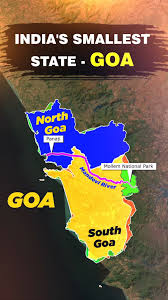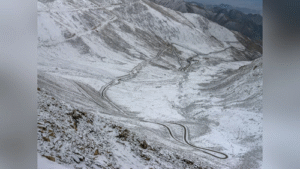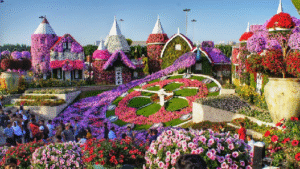Goa, located on the western coast of India, stands out not only for its small geographical size but also for its rich cultural heritage and economic significance. Here’s a detailed look into Goa’s geography, history, culture, and economic importance.
- Area: Goa spans a relatively small area of 3,702 square kilometers, making it the smallest state in India by land area.
- Percentage of India’s Total Area: Goa constitutes about 0.11% of India’s total land area (which is approximately 3.287 million square kilometers).
- Goa is situated on the western coast of India, bordered by the Arabian Sea to the west.
- To the north, it shares a border with the Indian state of Maharashtra, while to the east and south, it is bordered by Karnataka.
- Goa is known for its scenic coastline, with numerous beaches, as well as its lush greenery and rich biodiversity.
- Goa was under Portuguese colonial rule for over 450 years (from 1510 to 1961). The Portuguese influence on the state’s culture, architecture, religion, and lifestyle is still deeply evident today.
- After India gained independence in 1947, Goa remained a Portuguese colony until it was liberated and annexed into India on 19 December 1961 by military action, known as Operation Vijay.
- Initially, Goa became a union territory of India after its annexation.
- On 30 May 1987, Goa was granted statehood, making it the 25th state of India.
- Goa is renowned for its beautiful beaches, such as Anjuna, Calangute, Baga, and Palolem. These beaches attract both domestic and international tourists.
- The state’s landscape is dotted with lush green forests, rivers, and waterfalls, contributing to its rich biodiversity.
- Goa experiences a tropical climate, with hot and humid weather for most of the year, followed by a monsoon season (June to September) that brings heavy rainfall.
- Goa’s Portuguese colonial heritage is evident in its architecture, art, music, and cuisine. Historic churches and forts, such as Basilica of Bom Jesus, Se Cathedral, and Aguada Fort, reflect this influence.
- The Portuguese introduced Christianity to Goa, and today, it remains the state with the highest percentage of Christians in India.
- Goa is famous for its vibrant festivals such as Carnival (a lively pre-Lenten celebration) and Shigmo (a spring festival). The state also celebrates major Hindu and Christian festivals with great enthusiasm, including Diwali, Christmas, and Easter.
- Folk music and dance forms such as Fado and Dekhnni are integral parts of Goan cultural expressions.
- Konkani is the official language of Goa, and it is widely spoken by the local population.
- English is also widely understood, especially in urban areas, and it is the medium of instruction in most schools and colleges.
- Marathi is also spoken in some parts of Goa, particularly in areas bordering Maharashtra.
- Goa is one of India’s most popular tourist destinations, renowned for its beaches, vibrant nightlife, and Portuguese heritage architecture. Tourists flock to the state for its beach resorts, luxury hotels, and beach parties, contributing significantly to the state’s economy.
- Goa’s economy is heavily reliant on tourism, which supports a variety of industries, including hospitality, entertainment, retail, and food services.
- Goa’s agriculture is primarily focused on rice, coconut, cashew, and spices like black pepper and cardamom. Goa also has a thriving fisheries industry, thanks to its coastal location.
- Goa has been an important producer of iron ore and manganese, contributing to the mining sector. However, mining activities have faced environmental concerns and regulatory challenges in recent years.
- The state also has a growing industrial sector, including chemical manufacturing, pharmaceuticals, and food processing.
- Capital: Panaji (also known as Panjim) serves as the state capital and is located on the banks of the Mandovi River. It is a relatively small yet vibrant city known for its Portuguese colonial architecture and cultural landmarks.
- Largest City: Vasco da Gama is the largest city in Goa and serves as an important port city. It has a significant role in the state’s trade and commerce, particularly in shipping and logistics.
Despite its small size, Goa holds a prominent place in India’s socio-economic and cultural landscape. With its rich colonial heritage, breathtaking beaches, vibrant festivals, and tourism-driven economy, Goa continues to be one of the country’s most beloved and visited states. The influence of Portuguese culture, combined with its natural beauty, makes Goa a unique and cherished destination both for residents and travelers alike.







